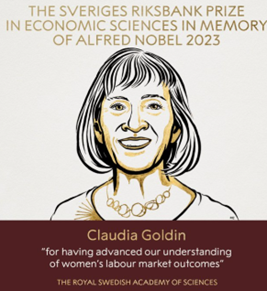Nobel Win Highlights Gender Workforce Gap
Relevance
- GS Paper 1 Role of Women and Women’s Organization, Population and Associated Issues.
- Tags: #NobelPrize #womenempowerment #EqualPay #ClaudiaGoldin #MintEditorial.
Why in the News?
Claudia Goldin’s Nobel Prize-winning work on Gender equality in labor markets highlights the need for governments to prioritize women’s participation, promote diversity, and optimize human resources.
Nobel Prize highlights Gender Inequality
- Claudia Goldin’s Nobel Prize win is ironic because her work on women in labor markets and gender equality highlights the gender disparity in Nobel laureates in economics.
- Since the prize’s inception in 1969, only two women, Elinor Ostrom in 2009 and Esther Duflo in 2019, have won it.
- Goldin’s research on women’s success in the labor market is timely, given the global focus on ending gender discrimination, making her achievement all the more significant.
Education Alone Doesn’t Ensure Equal Job Opportunities
- Despite efforts to educate girls, many still drop out of the labor force mid-career due to discrimination.
- Claudia Goldin’s research reveals that gender gaps persist even with economic development, highlighting flaws in various economies.
- Economic growth doesn’t always lead to better job outcomes for women, emphasizing the need for comprehensive gender equality measures.
Key Changes Required for Gender Equality
First – Changing Social Norms
- In many conservative societies, social norms act as barriers for women.
- Traditionally, some societies discourage girls from getting too much education or working after completing their education.
- While Western economies saw more women joining the workforce as they developed, this trend didn’t apply to countries in Asia and Africa.
- To empower women economically, it’s essential to challenge and change these restrictive norms.
Second – Shift from Agrarian to Industrial Society
- In the United States, as the country shifted from an agrarian to an industrial society, women’s labor participation initially declined.
- Industrial jobs were often seen as physically demanding and not suitable for women.
- However, with the growth of the service sector, more opportunities for women emerged.
- The availability of contraceptive pills also played a crucial role by allowing women to work after marriage.
- Laws mandating workplace welfare and safety further encouraged women to join the workforce.
Third – Gender Pay Gaps
- Historically, gender pay gaps have existed across all sectors.
- Breaks taken for childbirth often contribute to these disparities, limiting women’s career progression and widening pay gaps.
Fourth – The Role of Expectations
- Claudia Goldin points out the influence of expectations.
- Women have become more ambitious in recent decades, partly due to the influence of Role Models.
- Earlier generations had different working patterns, as many women did not return to work after childbirth.
- Closing the pay gap with men was a slow process. However, times have changed, and employers now seek gender diversity, which has raised expectations.
- This shift is also noticeable in India, reflecting positive progress.
Fifth – Generational Change
- Goldin’s research indicates that change is happening rapidly, especially in wealthy countries, and is more evident among younger generations.
- This suggests that we can anticipate further Generational shifts in the coming years towards greater gender equality.
Lessons for Governments in Promoting Equality
First – Prioritizing Gender Equality
- Governments must make gender equality a top priority.
- This starts with ensuring girls’ access to education and providing cash incentives, similar to the successful mid-day meal scheme in some states.
Second – Creating a Supportive Environment
- To enable women to work effectively across all fields, including agriculture, mining, manufacturing, and services, governments should create a conducive environment.
- This includes regulating work-hour limits and offering extended maternity leave (up to 26 weeks).
- Factories should provide on-site crèche facilities to prevent women from leaving the workforce due to childbirth.
- Encouraging private sector investment in childcare centers can also make a difference.
Third – Promoting Flexible Work Arrangements
- The COVID-19 pandemic has shown that remote work, or “work from home,” can be a viable option.
- Governments can encourage companies to offer this flexibility to women employees, allowing them to work continuously without career breaks.
Fourth – Breaking Gender Barriers
- Certain professions, often related to security concerns, remain male-dominated, such as food delivery and public transport driving.
- State governments should create a safe and inclusive environment for women to work in these roles, promoting financial independence.
Fifth – Affirmative Action for Women
- Implementing affirmative action measures can be beneficial.
- For example, the Securities and Exchange Board of India has made it compulsory for companies to have at least one woman director on their boards.
- Similar requirements can be considered for women in top management roles to serve as role models for others.
- Additionally, offering lower tax rates for women below a specific income threshold can act as an incentive.
A Wake-Up Call
Claudia Goldin’s Nobel Prize should serve as a wake-up call for governments to focus on improving women’s participation in the labor market. This not only promotes diversity and gender empowerment but also optimizes the use of human resources.
|
Nobel Prize in Economics
1st Nobel Prize in Economics
How many Indians have received the Nobel Prize in Economics?
What do Nobel Prize winners in Economics receive?
|
Source: Livemint
Mains Question
Analyze the factors that contribute to gender gaps in pay and labor force participation, as highlighted by Claudia Goldin’s research. How can governments address these issues to promote gender empowerment?




